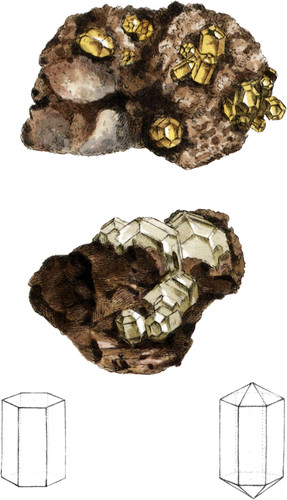 Enlarge
Enlarge
Exotic Mineralogy
Arsenio-phosphate of Lead
- Syn.
- Muschliches and Fasriges Phophorblei. Karsten, tabs. 68, 69, and 99.
- Plomb phophaté arsenié. Haüy 3, 496.
- Plomb phophaté arsenifère. Haüy Tabl. 83.
- Plomb phosphaté. Bournon Catal. 349.
Beautiful yellow crystals of Phosphate of Lead, holding much arsenic acid in combination, were discovered some years ago at Johanngeorgenstadt, in Saxony, and have ever since been much admired. Different opinions exist respecting the propriety of considering them as of a distinct species from Phosphate of Lead, along with a mamillated variety found at Hosiers, in the department of Pay de Dome, which is similar in composition to it. Haüy and Bournon consider tin; arsenic acid as accidental; the first inclining to an opinion that the arsenic acid is united with a portion of Lead, and mixed with the Phosphate in the form of Arseniate of Lead. Whether it be a combination, or only a mixture, will long remain a question.
The gangue of the specimens figured is granular Quartz, stained upon the surface with oxide of Iron.
Analysis of the yellow crystals from Johanngeorgenstadt:
| By Laugier. | By Rose. | ||
|---|---|---|---|
| Oxide of Lead | 76.8 | 77.5 | |
| Phosphoric acid | 9.0 | 7.5 | |
| Arsenic acid | 4.0 | 12.5 | |
| Water | 7.0 | Muriatic acid | 1.5 |
| Silex Alumine and Iron | 1.5 | ||
| Loss | 1.7 | 1.0 | |
| 100.0 | 100.0 |
Analysis of the mamillated variety from Rosiers:
| By Fourcroy. | By Klaproth. | ||
|---|---|---|---|
| Oxide of Lead | 50 | 76 | |
| Phosphoric acid | 14 | 13 | |
| Arsenic acid | 29 | 7 | |
| Oxide of Iron | 4 | Muriatic acid | 1.75 |
| Water | 3 | 0.5 | |
| Loss | 1.75 | ||
| 100 | 100.00 |
The action of the blowpipe, with charcoal, readily points out the nature of a doubtful specimen, by dissipating the arsenic in fumes with the scent of Garlic, leaving the Phosphate of Lead in a facetted button of opaque glass.

